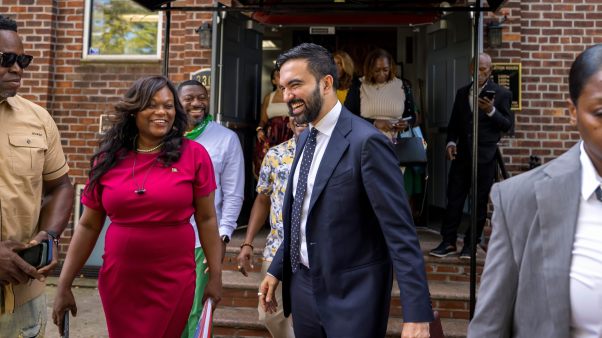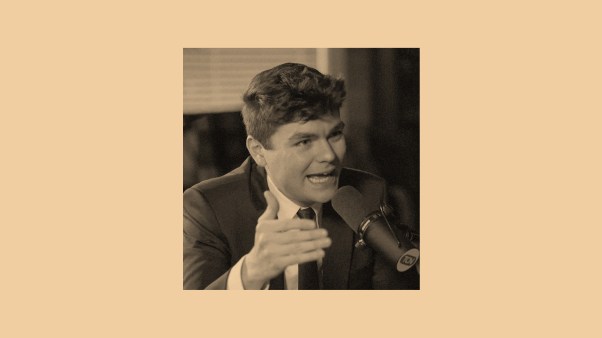This new, yet familiar movement is surprisingly prevasive among evangelicals. What is it, and what are we to make of it?
In the early 1980s, Southern Baptist evangelist James Robison scandalized many of his conservative constituents with a new emphasis on so-called charismatic practices. The ensuing controversy focused on divine healing and deliverance from demons, but few seemed to appreciate the deeper significance of the shift: By 1984, the evangelist whose name had become associated nationwide with the New Right political agenda was embracing wholeheartedly the theme of the “restoration of the body of Christ.” Restoration became his watchword in everything—his syndicated television program, his magazine, his preaching ministry. Robison has lately distanced himself from restoration theology, but restoration themes still figure prominently in his ministry.
The new theme in James Robison’s ministry represented the emergence of a new, yet familiar influence in the evangelical garden—charismatic restorationism. While it takes different forms, the movement argues that the modern church has lost the power, patterns, and spiritual gifts of the New Testament church, all of which can and should be recovered.
The influence of restorationism is growing among evangelicals—perhaps more than they realize. New forms of worship and contemporary styles of praise music are permeated with its themes. Renewal churches seeking “new wineskins” gravitate toward it. Are you hearing of new apostles and prophets? Restorationism promotes them. It has also made connections with the “signs and wonders” movement on the one hand (CT, Aug. 8, 1986, p. 17), and Christian Reconstruction (CT, Feb. 20, 1987, p. 17) on the other, but it remains distinct from both.
Remarkably, few evangelicals or even charismatics seem to know much about the new restorationism. Is it a latter-day gift of the Sower, the encroachment of an alien seed, or the resurgence of a dormant strain?
In Search Of The “True Church”
In understanding the movement, we should first realize that the restorationist impulse is nothing new to the church. The basic principle of all forms of restorationism is that there is a fundamental discontinuity, historical and spiritual, between the church as it is described in the New Testament and the church as it is today—that there has been a fall, and the church is thus in need of restoration.
Perhaps the first modern restorationists were the Anabaptists—the sixteenth-century radical reformers whose theme was the “restitution” of the true church. Later, around 1830–40, no less than three distinct restorationist movements arose: the Plymouth Brethren and the Catholic Apostolic Church in Great Britain, and the Disciples of Christ in America.
We find the direct ancestors for the charismatic restorationists of today in the early Pentecostal movement. The first Pentecostal apologists proposed that God will restore the Bride of Christ in the latter days through the renewal of the spiritual gifts of the apostolic age. Surely, they argued, the Pentecostal revival must be the “latter rain” Spoken of in Joel 2:23 and elsewhere in Scripture.
By the late 1920s, however, the “latter rain” motif waned in Pentecostal preaching and sat dormant for two decades. Then, in 1948, it became welded to a passionate revival of the Pentecostal gifts, which erupted in Saskatchewan, Canada, and soon spread. Besides the gift of tongues, the Latter Rain movement was marked by prophesying, miraculous healings, the laying on of hands, “liberated” worship, the singing of psalms and Scriptures set to music, and phenomena such as “singing in the Spirit” and hearing “angelic choirs.” Hebrews 6:1–2, with its mention of baptisms and laying on of hands, was taken quite literally as the foundation of Christianity and was used as a virtual Apostles’ Creed for Pentecostalists.
The Latter Rain movement was largely rejected by the Pentecostal denominations. Several of its leaders became notorious for extremism and religious racketeering. More temperate versions of its message survived, however, scattering across the English-speaking world. Many who were caught up in the Latter Rain movement in their formative years later became influential in the charismatic movement and, in turn, in the Third Wave (a term for evangelicals who embrace the reality of supernatural and charismatic gifts without necessarily changing their theology or denominational identity). Charismatics emerging from denominational churches had never heard of the Latter Rain controversy, and they could listen without prejudice to what old-line Pentecostalists viewed with suspicion and hostility. Consequently, restorationism acquired a stronger presence within charismatic renewal than it ever did in the Pentecostal movement. At a Third Wave conference last summer, the book table was laden with restorationist materials. The conference sponsors were not trying to “push” the restoration message. Those books simply seemed compatible with what they were doing.
One influential center of the Restorationist movement that appears to draw on Latter Rain thinking is the Bible Temple in Portland, Oregon. The books, tracts, teaching tapes, and music put out by Bible Temple Publishing have gained a wide distribution through mail-order channels, conferences, churches, and religious book stores. Its Portland Bible College offers two-and four-year programs, helping to ensure the extension of its influence to a new generation. Bible Temple also sponsors a Christian grade school and a high school, as well as a home cell-group shepherding program.
Dick Iverson, senior pastor of Bible Temple, disavows the extreme practices and doctrinal heresies of the Latter Rain. But he acknowledges and embraces what he believes were its wholesome influences. Interestingly, his wife, Edie, was attending the Bible college in North Battleford, Saskatchewan, when the Latter Rain Movement broke out there. His book Present Day Truths is still in circulation as a classic manifesto of restorationism.
Another leader with restorationist leanings is Larry Tomczak. In his autobiographical Clap Your Hands, Tomczak describes his spiritual journey from radical college student to leader of an “apostolic team” overseeing over 20 churches in the U.S., Mexico, and the Philippines. Transformed through the charismatic and Jesus movements, Tomczak gave up a promising career in labor to enter the ministry. His “burning desire” was to see “twentieth century Christians recapturing an authentic biblical lifestyle.” Until recently, Tomczak was the team leader (director) of the People of Destiny, International, apostolic team, based in Gaithersburg, Maryland. (Now he is assistant director, succeeded by C. J. Mahaney.) Tomczak is also founder and editor of People of Destiny magazine. The group has moderated early stands and now places more value on God’s work throughout history.
Tracking Restorationism
The extent of restorationism’s influence is for the most part unmeasured, and few have studied it. An important exception is Andrew Walker’s Restoring the Kingdom, an analysis of the restoration “house church” movement in England, by a scholar trained both in sociology and theology. Writing as a “friendly outsider,” Walker observed two main branches within the Restoration movement, calling them R-l and R-2 (see “Restoring the Kingdom in England,” p. 30). R-ls tend to be more doctrinaire, emphasizing the need to restore the primitive forms of the church as the foundation for unity. The R-2s put greater stress on unity as the primary goal of restoration. (A similar split in what became the Disciples of Christ denomination brought forth the Churches of Christ, well-known especially in the South for their prohibitions against any congregational practices not specifically mentioned or dictated in the New Testament.)
A few years after the revised, 1988 edition of Restoring the Kingdom, Walker doubts that the old categories still hold. The movement has by now divided, diversified, realigned, and diffused almost beyond recognition. This suggests that the Restoration movement is becoming diluted. It may also mean, however, that its message is penetrating old barriers, affecting charismatic and evangelical groups in England while itself being tempered. It is estimated that there are around 100,000 adherents among the restorationists of England—a sizeable chunk of that nation’s evangelical corps.
Not even approximate figures are available for America; church-growth analysts do not have a category for it. Here restorationism is less of a sociological movement and more of a religious leaven. It is a doctrine propagated through networks of churches, institutions, conferences, and writings. Besides those with the word restoration in their name, one can only guess how many churches have tasted of the influence. Also, not everyone knows of what they are tasting.
Earl Paulk, Jr.: A Different Drummer
He is recognized by the clerical collar, uncommon on the neck of Pentecostalist preachers, and by the title of bishop—which is an uncustomary one for a local-church pastor. To say that Bishop Earl Paulk of Chapel Hill Harvester Church in Atlanta is a maverick restorationist would be an overstatement. Yet he is outspoken and bold to the point of incautiousness, and some of the most extreme statements of the restorationist perspective have come from him. This trait has sometimes landed him in controversy with watchdogs ranging from Dave Hunt to Jimmy Swaggart. Especially troublesome were statements made several years ago that seemed to echo the old Latter Rain heresy that prophetic revelation today is on a par with the Bible. Paulk quickly disavowed any Latter Rain connections, contending that his use of the term revelation was misunderstood.
Paulk also has been known for his “Kingdom Now” or dominion theology. Some of his statements have resembled the reconstructionist language of Gary North. Paulk, however, denies that he is a postmillennialist. He does believe that Satan has held sway too long in every sphere of life, ranging from politics to the arts. It is time, he argues, for the church to take back dominion from Satan in all these realms. Any observer can see that Paulk means business. Chapel Hill Harvester Church, with a membership of 12,000, over 7,000 attenders weekly, and almost two-dozen full-time pastoral-staff members, is one of the largest churches in the nation. It is known inracially torn Atlanta for its quest for a fully integrated church, and for its social-outreach ministries to the hungry and homeless.
Paulk has a television ministry carried by the Trinity Broadcasting Network. He also is the author of several books, published by Kingdom Publishers, including Satan Unmasked (1984), Ultimate Kingdom, a commentary on Revelation (1986), and most recently, The Church: Trampled or Triumphant? (1991).
What Sets Restorationists Apart
The new restorationism represents a refinement and further development of the message and practices of the Latter Rain Movement. Influence upon worship can be seen in Hebraic styles of music and dance, and physically demonstrative praise. Contemporary songs that have a martial flair or a spiritual-warfare accent also show the influence. Not all who have been influenced by restorationism are full-fledged advocates. But these distinguishing themes set them apart:
• The kingdom of God is here. Many restorationists have come out of dispensationalism, and their understanding of the kingdom is in sharp contrast with their old view. The kingdom is the reign of God, now manifested through the church in the power of the Spirit, though not necessarily coextensive with the visible church. It is militant, in constant conflict with the kingdom of darkness—and it is on the increase. Not surprisingly, restorationists have found common ground with advocates of “power evangelism.” Their kingdom theology resembles, in some respects, that found in theologian of hope Jurgen Moltmann’s book The Church in the Power of the Spirit. The restorationists are more comfortable, however, quoting the late New Testament theology professor G. Eldon Ladd of Fuller Theological Seminary—when they quote someone at all besides the Bible.
The eschatology connected to this “kingdom now” theology is difficult to categorize as pre-, post-, or amillennial. When restorationists speak of its establishment in the present age, they sound like postmillennialists. They have been confused with Christian reconstructionists for this reason. Yet most of them stop short of saying that the church will fulfill the kingdom before the return of Christ. Most writers on the subject decisively reject dispensationalism, called by English restorationist Arthur Wallis “that theology of disaster.” Likewise, while they believe that “all Israel shall be saved,” they do not regard the Jews as the people of God apart from the New Covenant.
• The church has fallen, but God is restoring her. If the first point discomfits the dispensationalist, the believer from a Catholic, Orthodox, Reformed tradition—or from any denomination, for that matter—is likely to be offended by restorationism’s recapitulation of church history. If you are in such a church, it is implied, God has moved on, and you’ve been left behind.
In brief, after the apostles died, everything began to slide until the church finally languished in the Dark Ages. At the Reformation, God began progressively to restore “the years the locust has eaten” (Joel 2:25). Denominations formed as people idolized each phase of the divine renewal. Yet God will continue to restore the church until denominational barriers fall and the church finds unity through the fivefold ministry gifts (apostles, prophets, evangelists, pastors, and teachers; see Eph. 4:11), led by his modern-day apostles.
• Apostles and prophets are for today. While even some traditional evangelicals talk about acknowledging “apostolic” and “prophetic” ministries in the church today, restorationists are serious about it. Their assumption, based on Ephesians 4:11, is that there is a New Testament apostleship besides that of the first-century variety. Apostles are the men (apparently not women) who are gifted to be the architects of the church. Their authority is charismatic, not formal.
Likewise, God continues to speak to the church through prophets, who impart vision and correction to the church. Their revelation is not to supersede the Scriptures, but to apply them, or to speak where they are silent. Neither apostles nor prophets have coercive authority, but the church fails to heed them at its peril.
• The church is governed by elders, shepherds of the flock. Restorationists assume that the fivefold ministry encompasses the eldership that rules the church. Their church government is not classical presbyterianism, however. Appointment to office is seen as coming through divine selection, not democratic election. In practice, it is the elders themselves who summon (or release) one another from the ruling body of elders. It is not clearly explained how such an oligarchic arrangement is more theocratic than congregational democracy or a hierarchical episcopacy.
The commission of the elders is to shepherd the flock of God. The intensity of this activity varies, however. The R-1 group in England (through the influence of Latter Rain alumnus Era Baxter) adopted the close accountability practices that so divided charismatics in the U.S. in the 1970s. Shepherding, alloyed with apostolic authority, produced what many regarded as an almost cultic hierarchy. For the present, the shepherding movement in England, as in the U.S., is on the way out.
• God is restoring the tabernacle of David. What this means in practice is that there is a biblically prescribed order of worship. Behind the revival of Jewish folk music and dance and the demonstrative expressions of praise is an interesting—some would say odd—interpretation of Acts 15:16’s mention of God rebuilding David’s fallen tent (cf. Amos 9:11). Restorationists say it refers to the tent that David built for the ark of the covenant when he brought it into Jerusalem. They point out that until Solomon built the temple, there were two regimes of worship: sacrifice at the altar on Mount Gibeon, and praise before the ark on Mount Zion. The latter represents the free access of the believer to the throne of grace. Since Davidic liturgy was a foretaste of worship in the New Covenant, it should therefore be studied and copied.
Restoring The Kingdom In England
Over the past two decades, restoration churches in England have been something of a sociological phenomenon, with several interesting and significant leaders. Here are a few whose influence continues to be strong in an ever-shifting and dynamic restorationism:
Arthur Wallis (d. 1989). Best known in the U.S. for his books on spiritual awakening, In the Day of Thy Power and God’s Chosen Fast, Wallis was a highly revered father figure to virtually all restorationists. Curiously, he never found (nor sought) recognition as an apostolic leader in the movement. His vision of a church restored to New Testament unity, vitality, and structure is sure to live on through the generation of those who knew him.
Bryn Jones. The powerful leadership of this fiery Welshman lies behind much of the dynamic growth of R-1 restorationism from the mid-1970s through the mid-1980s. It has also provoked schisms that have riven the movement. One of the original restoration apostles, Jones continues to oversee a ministry in northern England that some observers regard to be more separatist than restorationist. He maintains control over the bimonthly magazine Restoration and has influence over nearly a score of churches planted in a number of major cities across the U.S.
Gerald Coates. Voluble but less intense than Bryn Jones, the London-based Coates typifies the more moderate R-2 movement and its emphasis that is less on recovering the form of early Christianity and more on restoring its unity. Recently Coates has bitterly disputed Andrew Walker’s account of restorationism in Restoring the Kingdom—although Walker’s portrayal can hardly be called uncharitable.
Terry Virgo. A protege of the late Martyn Lloyd-Jones, Virgo possesses evangelical and Calvinist credentials of which none of the other restorationists can boast. These, along with an irenic spirit, have gained him entrance into diverse evangelical circles on both sides of the Atlantic that would otherwise remain closed to the Restoration message. His book Restoration in the Church is a winsome and uncontentious presentation of the restorationist argument. A long-term assessment may show Virgo to be the most influential of the restorationists in England.
The Future Of The Movement
In view of the centuries-long history of the restoration ideal, and the current worldwide strength of the Pentecostal, charismatic, and Third Wave movements, it is reasonable to expect the new restorationism to continue to be an influence for the forseeable future. It is likely to spread into different cultures in Latin America, Asia, and Africa, and may gain some prominence there. Historically, however, restoration fervor has tended to be a one-generation phenomenon. Later generations either establish denominational institutions, become sectarian, or disperse. Should the Lord tarry, a similar end may be expected of today’s charismatic restorationists.
In assessing restorationism, we should recognize that the restorationist message is within the stream of Christian orthodoxy and that these are true brethren, not a cult group. Nevertheless, without becoming disputatious over particular points, there are significant areas of concern about this charismatic restorationism.
First, restoration churches have sometimes provided more of a harbor for dissatisfied church members than a lighthouse for lost souls. This is not necessarily bad—bored and burned-out Christians need to be churched somewhere. But the introversion that characterizes some restorationism is not conducive to the spread of the gospel.
Second, there is a problem with balance when it comes to biblical interpretation. The quest for the correct pattern can easily turn the New Testament into a handbook of church structure. Biblical typology is given the force of injunction, and apostolic examples are regarded as commandments. It is one thing to interpret the Bible literally as the supreme authority; it is quite another to use the Bible dogmatically and in a way that insists that congregational life today must replicate that of the first-century church. Restorationists often seem not to know the difference between rules and principles.
Third, the restorationists’ review of church history is simplistic and superficial—some may say arrogant. Their historiography attempts to imitate the Old Testament chronicler, but their authority for doing so is precarious.
The very use of the term restoration in reference to the church is problematic. In Scripture it is used rarely and signals the eschatological consummation of the kingdom. It is not just a stronger word for renewal or revival.
A fundamental theological problem underlies all the above concerns: perfectionism—not for the individual, but for the church. This perfectionism (which I believe is mostly held unconsciously) betrays the principle of justification by faith as it applies to the church. The burden of restorationism is that Christ will return for a pure and unblemished Bride, not one that is stained, shamed, and divided. But how pure does she have to be before he will come for her? Does the purity of the Bride reside in herself, or in the Bridegroom? Ephesians 1 makes it clear that there is a perfection of the church that is eternal and unconditional, that depends on the worthiness of Christ and not on herself.
Having said these things, it should be noted that the imbalance of restorationism points out that the church is out of balance in the other direction. The church truly is to pursue perfection, “to lead a life worthy of the calling to which [she was] called” (Eph. 4:1). Likewise, the vigor and enthusiasm with which restorationists study and practice worship is stimulating and healthy. Besides, when compared to the wide disagreement among commentators regarding the tabernacle of David, the restorationist view does not really seem all that far-fetched!
The optimistic kingdom theology is also a strong point, although hampered by theological fuzziness or lack of consensus in application. We may also commend the restorationist zeal for a church that is truly led and empowered by the Spirit in the same way the early church was.
Above all, we can be moved by the restorationist passion for a unity of believers that goes beyond sporadic union for special projects. Restorationism’s cogent critique of denominationalism challenges evangelical and charismatic complacency with divisions in the body of Christ. While restorationism may not be the answer, there is a special poignancy in the cry of one leader: “Why isn’t there just a Christian community?”
If restorationists and others keep asking such questions, perhaps by God’s grace we will one day find out.
Rick Godwin: Flying With The Eagles
A graduate of Bob Jones University, Rick Godwin was an associate evangelist with James Robison in the early 1980s. Around the same time Robison began to change course, Godwin also found his own fundamentalist attitudes toward the supernatural work of the Holy Spirit changing. In 1983, a young Baptist minister named Mike Berry introduced Godwin to the idea of the restoration of the church. Godwin took to it immediately. As he studied restorationist materials Berry sent to him, he testifies, “God began to reveal to me that without a ‘Divine Pattern,’ we will never produce a ‘Divine Result.’ ”
Doubtless, Godwin, himself a powerful preacher and teacher, carried a strong influence of restorationism to Robison and his other associates. He soon left Robison’s evangelistic association to establish the Eagle’s Nest Christian Fellowship in San Antonio, Texas. The church has a number of branches and extensions, supervised by “apostolic ministry teams.” While not as extensive as Larry Lea’s Church on the Rock, the Eagle’s Nest network of churches is similarly on the way to becoming almost a “new denomination.” Godwin also has a weekly teaching television program on the Trinity Broadcasting Network. He is regarded by many in the movement as possessing an apostolic “anointing” on his ministry.










